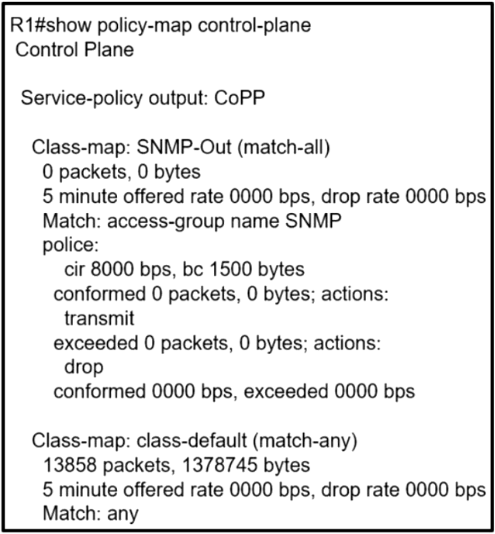
Refer to the exhibit. How does the router handle traffic after the CoPP policy is configured on the router?

Refer to the exhibit. How does the router handle traffic after the CoPP policy is configured on the router?
I believe the correct answer is A because it is described on the output "Service-policy output: CoPP, so traffic will be policed.
Can confirm, output for input reads: “Service-policy input:”
"Only ingress CoPP is supported. The system-cpp-policy policy-map is available on the control plane interface, and only in the ingress direction". https://www.cisco.com/c/en/us/td/docs/switches/lan/catalyst9300/software/release/16-11/configuration_guide/sec/b_1611_sec_9300_cg/configuring_control_plane_policing.pdf Therefore, A can't be right. B is the answer.
The system-cpp-policy policy map is a system-default policy map. The policy map mentioned in the question is a manual policy map named CoPP
Service Policy is in the output direction. So traffic generated by router will be policed.
Come on guys, the correct answer is C. "Another special note on Cisco ACLs is that ACLs never apply to traffic generated by the router. So, even if you have an inbound and an outbound ACL on a router denying all traffic, the router will still be able to send any packet it wants; the return packet, however, will be blocked as usual" https://www.ciscopress.com/articles/article.asp?p=174313&seqNum=4
A is correct. Notice the keyword "output"
https://www.cisco.com/c/en/us/td/docs/ios/12_2sb/feature/guide/cpp.html * input—Applies the specified service policy to packets received on the control plane. * output—Applies the specified service policy to packets transmitted from the control plane and enables the router to silently discard packets.
From oficial book, " CoPP supports inbound and outbound policies; however, outbound policies are not commonly used." So, I believe A is ok.
B is correct. A is not true. CoPP policies do not apply to traffic generated by the router itself, but rather to incoming traffic to the control plane
A is correct. Because service policy is applied to control plane. So router generates the traffic. Control plane is the key word why Choose A.
I believe the correct answer is A because it is described on the output "Service-policy output: CoPP, so traffic will be policed
would go with A
"the Control Plane Policing feature treats the CP as a separate entity with its own interface for ingress (input) and egress (output) traffic. " https://www.cisco.com/c/en/us/td/docs/ios/ios_xe/sec_control_plane/configuration/guide/2_xe/cps_xe_book/ctrl_plane_policng_xe.html#wp1082901
The CoPP policies restrict known traffic to a specific rate while protecting the CPU from unexpectedly high traffic rates that might jeopardize the router's stability.
"To protect the CP on a router from DoS attacks and to provide fine-control over the traffic to or from the CP, the Control Plane Policing feature treats the CP as a separate entity with its own interface for ingress (input) and egress (output) traffic"
A. Traffic generated by R1 that matches access list SNMP is policed. This option is incorrect because CoPP does not police traffic generated by the router itself (R1). B. Traffic coming to R1 that matches access list SNMP is policed. This is the correct answer. CoPP polices traffic coming to the router (R1) that matches the specified access list (SNMP). C. Traffic passing through R1 that matches access list SNMP is policed. CoPP does not police transit traffic passing through the router; it only affects traffic destined for the router. D. Traffic coming to R1 that does not match access list SNMP is dropped. CoPP does not drop traffic that does not match the specified access list; it only polices it. Therefore, option B is the correct answer.
A is correct output is the keyword
i think A is correct
When applying the service policy to the control plane, the input direction is only supported. https://www.cisco.com/en/US/docs/general/Test/dwerblo/broken_guide/copp.html
Answer A I believe A is the correct one. https://www.cisco.com/c/en/us/td/docs/ios/ios_xe/sec_control_plane/configuration/guide/2_xe/cps_xe_book/ctrl_plane_policng_xe.html